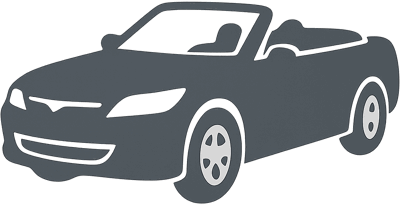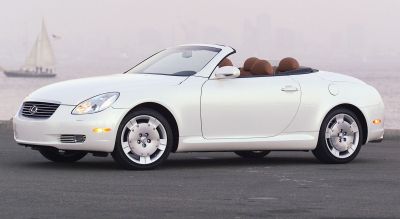 2002 Porsche 911 Cabriolet (996, facelift 2001) Dimensions, Size & Specs
2002 Porsche 911 Cabriolet (996, facelift 2001) Dimensions, Size & SpecsMeasurements of the 2002 Porsche 911 Cabriolet, engineered for optimal performance and comfort
| Dimensions | |
|---|---|
| Length: | 4430-4465 mm174.4-175.8 in14.5-14.6 ft |
| Width: | 1770-1830 mm69.7-72.0 in5.8-6.0 ft |
| Height: | 1295-1305 mm51.0-51.4 in4.2-4.3 ft |
| Trunk Capacity (Max): | 100-130 liter3.5-4.6 cu ft |
| Weight Specifications | |
| Curb Weight: | 1450-1620 kg3197-3571 lbs |
| Maximal permitted Weight: | 1855-2020 kg4090-4453 lbs |
| Tire Specifications | |
| Rims Sizes: | 18-inch rims:
|
| Tire Sizes: |
|
The Porsche 911 Cabriolet (996 facelift 2001), produced from 2000 to 2005, represents an iconic era of Porsche’s revered 911 lineage, perfectly blending classic design cues with modern engineering upgrades. This generation's Cabriolet model offers a stylish open-top driving experience, emphasizing sporty performance alongside practical daily usability. It features an overall length ranging from 4430 mm to 4465 mm (174.4 to 175.8 inches), a width between 1770 mm and 1830 mm (69.7 to 72.0 inches), and a height varying from 1295 mm to 1305 mm (51.0 to 51.4 inches), striking a balance between compactness and road presence. With a curb weight between 1450 kg and 1620 kg (3197 to 3571 lbs), the Cabriolet remains competitive among luxury sports convertibles, while its maximum weight ranges from 1855 kg to 2020 kg (4089 to 4453 lbs), indicative of its solid build and safety features.
The luggage capacity measures between 100 and 130 liters (3.5 to 4.6 cubic feet) with the rear seats folded, offering modest cargo space typical for a sports convertible designed for spirited driving rather than extensive hauling. The Porsche 911 Cabriolet rides on rim sizes varying from 7J x 17 inches up to 11J x 18 inches, paired with tire sizes such as 225/40 R18 and 295/30 R18 on the rear for enhanced traction, as well as 205/50 R17 and 255/40 R17, ensuring a mix of agility and grip tailored to its high-performance nature.
Overall, the 996 facelift Cabriolet maintains Porsche’s commitment to delivering a thrilling yet refined driving experience, perfect for enthusiasts seeking open-air motoring combined with the distinctive 911 character. The dimensions and weights reflect its heritage as a nimble but well-built sports car, making it a benchmark for cabriolet sizes in the early 2000s sports car segment.
Discover the standout features that make the 2002 Porsche 911 Cabriolet a leader in its class
Have a question? Please check our knowledgebase first.
The Porsche 911 Cabriolet (996 facelift 2001) model from 2002 has a length ranging between 4430 mm to 4465 mm (approximately 174.4 to 175.8 inches). This length positions it as a relatively compact sports car when compared to other luxury convertibles in its class, which often range between 4500 mm to 4700 mm in length. The relatively shorter length helps the 911 maintain its iconic compact silhouette ideal for agile handling, while still offering adequate interior space for a driver and passenger along with minimal luggage capacity. This length balance supports sporty driving dynamics, making the 911 Cabriolet distinctive in both look and performance within its niche.
The width of the Porsche 911 Cabriolet (996 facelift 2001) ranges from 1770 mm to 1830 mm (roughly 69.7 to 72 inches). This width provides a stable stance, essential for sports car handling, especially during high-speed cornering. A wider track enhances grip and stability without compromising the car's agility. Interior-wise, the width is sufficient to provide a comfortable seating arrangement for two passengers with some room for adjusting seating positions, though the cabin remains snug, as is typical for a sports convertible. The width ensures the car fits well on standard roads and parking spaces while still exuding a broad, sporty look.
The height of the Porsche 911 Cabriolet from the 996 facelift generation (2001 model onwards) ranges between 1295 mm to 1305 mm (approximately 51 to 51.4 inches). This low height contributes significantly to the vehicle's low center of gravity, which improves handling, cornering stability, and overall aerodynamic efficiency. The lower roofline also enhances the sporty aesthetic typical of the Porsche 911 lineup. While the cabriolet roof mechanism slightly influences the height compared to a coupe, the design keeps the sports car profile sleek and performance-oriented, balancing elegance with functionality.
The curb weight of the Porsche 911 Cabriolet (996 facelift 2001-2005) ranges between 1450 kg and 1620 kg (approximately 3197 to 3571 pounds). This weight range reflects the variations depending on specific trim, options, and equipment. The relatively lightweight nature ensures nimble and responsive driving characteristics, which is critical for a sports car like the 911. The moderate weight facilitates quicker acceleration, sharper handling, and better braking performance, while still providing enough mass to maintain stability at high speeds. Weight distribution in the rear-engine layout further enhances traction and dynamic balance.
The maximum weight for the Porsche 911 Cabriolet (996 facelift 2001) ranges from 1855 kg to 2020 kg (approximately 4089 to 4452 pounds). This figure indicates the combined allowable weight of the car, passengers, cargo, and optional equipment. Despite its sporty profile, the cabriolet cab offers a load capacity that comfortably supports two passengers and limited luggage. This maximum weight ensures that the car maintains optimal performance and safety without compromising suspension and braking systems. Owners should be mindful not to exceed this limit to sustain the driving performance and vehicle integrity.
The Porsche 911 Cabriolet (996 facelift) provides a luggage capacity ranging from 100 liters to 130 liters (approximately 3.5 to 4.6 cubic feet) with the rear seats folded. This space is relatively limited, reflecting the car’s sports-oriented design and compact dimensions. It is suitable for small bags, a couple of suitcases, or groceries but is not intended for large cargo or family trips. This capacity aligns with expectations for a two-seater luxury sports cabriolet and emphasizes the vehicle's focus on performance and style rather than utility. For everyday use, it is ideal for short trips or weekend getaways.
Yes, the Porsche 911 Cabriolet (996 facelift 2001) fits comfortably into a standard residential garage. Typical single-car residential garages measure about 2.4 to 3.0 meters (8 to 10 feet) in width and around 5.5 to 6 meters (18 to 20 feet) in length, which is sufficient for the 911 Cabriolet's length of 4430 mm to 4465 mm (14.5 to 14.7 feet) and width of 1770 mm to 1830 mm (5.8 to 6 feet). Its relatively low height (under 1.31 meters or 4.3 feet) also poses no issue with standard garage ceiling height. The compact yet sporty dimensions make the 911 easy to store in typical home garages without requiring special accommodations.
The Porsche 911 Cabriolet facelift of the 996 generation (2001-2005) features subtle dimensional changes compared to the original 996 produced from 1998 to 2001. Generally, the facelift model saw slight increases in length and width for improved styling and aerodynamics, with lengths from 4430 mm to 4465 mm versus slightly shorter dimensions pre-facelift. Width also increased from approximately 1750 mm to up to 1830 mm in later models, providing better road presence and stability. Weight differences are minor, with the facelift models sometimes slightly heavier due to updated safety, technology, and comfort features, though curb weight remained around 1450 to 1620 kg. These refinements enhance the facelift 996's performance and aesthetics while maintaining the core driving experience familiar from the original 996.
Compared to similar luxury sports convertibles from brands like BMW Z4, Audi TT Roadster, or Mercedes SLK from the early 2000s, the Porsche 911 Cabriolet (996 facelift 2001) is a compact yet slightly wider and lower option emphasizing sharp handling and rear-engine dynamics. Its length around 4.43 to 4.46 meters (174 to 176 inches) positions it between smaller roadsters and larger grand tourers. Its width of up to 1.83 meters (72 inches) provides a stable platform, enhancing cornering grip. The rear-engine layout delivers unique driving dynamics compared to front-engine rivals. While luggage capacity is more limited relative to some competitors, the 911's precise steering, weight distribution, and refined suspension make it more focused on driving engagement. This positions the 996 Cabriolet as a purist's choice among contemporary luxury sports convertibles.
The Porsche 911 Cabriolet (996 facelift 2001) came with a variety of rim sizes ranging from 8J x 18 inches up to 11J x 18 inches at the rear and 7J x 17 inches to 9J x 17 inches at the front, with tire sizes such as 225/40 R18, 295/30 R18, 205/50 R17, and 255/40 R17 depending on the trim and options. Larger wheels and wider tires improve grip and cornering capability by increasing the contact patch with the road, enhancing performance, especially in sportier models equipped with wider rear tires (up to 295 mm width). Conversely, larger rims with low-profile tires may result in a firmer ride over rough surfaces, balancing performance with comfort. Porsche's wheel and tire options allowed customers to tailor the 911 Cabriolet to preferred driving styles, from daily comfort to aggressive spirited driving.
Discover similar sized cars.

| Production: | 1999-2009 |
|---|---|
| Model Year: | 2000 |
| Length: | 4475 mm176.2 in |
| Width: | 1860 mm73.2 in |
| Height: | 1355 mm53.3 in |

| Production: | 2001-2005 |
|---|---|
| Model Year: | 2001 |
| Length: | 4515 mm177.8 in |
| Width: | 1825 mm71.9 in |
| Height: | 1350-1370 mm53.1-53.9 in |
